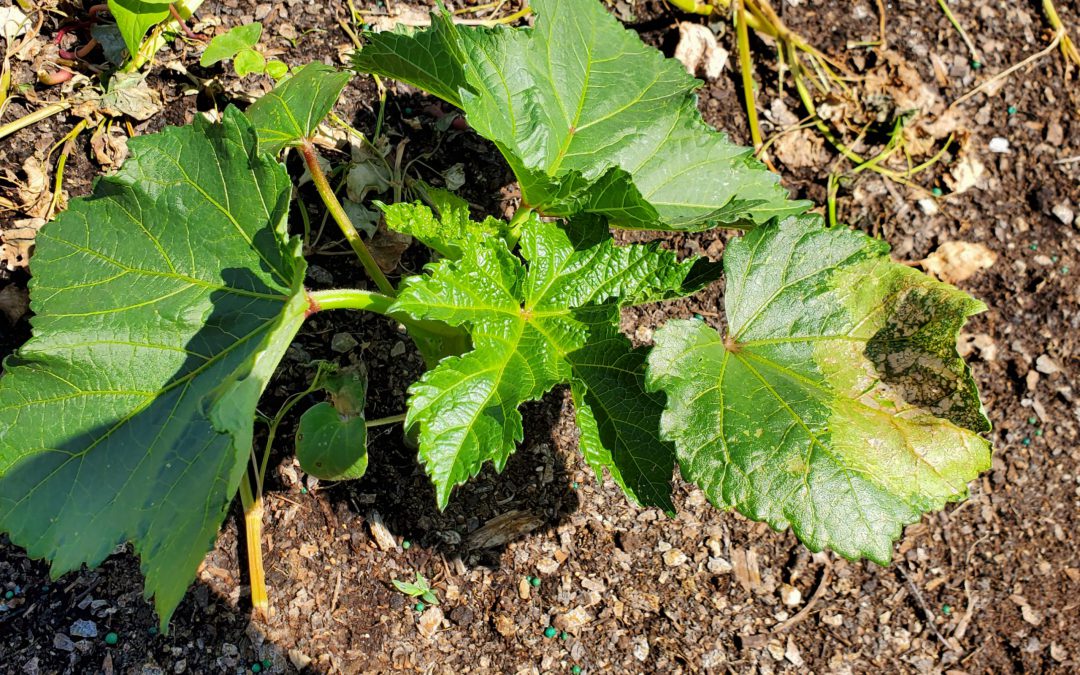
by Daniel J. Leonard | May 13, 2020
It’s been a challenging spring in this guy’s garden! Despite getting the normal early start required for successful gardening in Florida, I’ve been affected by Bacterial Leaf Spot stunting my tomatoes, cutworms that reduced my watermelon plantings by half, and an eternal test of my patience in the form of a dog that seems to think my raised beds are merely a shortcut to a destination further out in the yard. My latest adversary is the most potentially destructive yet, an outbreak of Southern Armyworm (Spodoptera eridania).
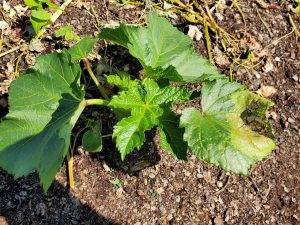
Early Southern Armyworm damage on Okra seedlings. Photo courtesy of the author.
Unlike some serious garden pests that wait until the heat of summer to emerge, Southern Armyworms begin appearing in spring gardens around the end of April. Adult moths can survive mildly cold weather and venture into the Panhandle as soon as warmer spring weather arrives. Once the adult moths arrive, egg masses are then laid on the undersides of leaves and hatch in a little under a week. Once loosed upon the world, Southern Armyworm larvae (caterpillars) become indiscriminate, voracious feeders and congregate in extremely large numbers, allowing them to destroy small, developing garden vegetable plants in a manner of days. Young larvae feed on the undersides of leaves and leave little but a skeleton. As larvae grow larger, they become solitary and begin to bore into fruit. Once they’ve eaten the good stuff (leaves and fruit), large larvae turn to branches and even plant stems!
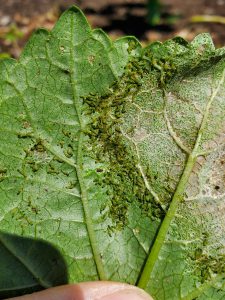
Southern Armyworm larvae feeding on Okra leaves. Photo courtesy of the author.
The good news for gardeners is that Southern Armyworm, and most other caterpillar pests, are easily controlled if outbreaks are caught early. Scouting is critical for early detection and good control. Armyworm damage generally appears from above as brownish-gray sections of affected leaves with a yellowish ring surrounding these sections, this ring indicates the current feeding zone. Affected areas will appear transparent and “lacy” due to the skeletonizing effects of larval feeding. If you see leaves that look “off” in the manner just described, check underneath for the presence of a horde of tiny greenish worms.
If found in this early stage, an application of Bacillus thuringiensis (Bt), a biological pesticide utilizing a bacterium destructive to caterpillars, is extremely effective. Bt has to be ingested by caterpillars with leaf tissue to work; thorough coverage of leaf surfaces is critical for maximum control. I generally follow up with a sequential application of Bt a day later to ensure that I achieved good coverage of the plant surfaces and, therefore, good control. Unfortunately, Bt is much less effective on older larvae. Infestations not caught early require harsher chemistries like carbamates, pyrethroids and organophosphates for adequate control.
Don’t let armyworms or other caterpillar pests destroy your garden, get out there daily and scout! You have a short window for easy caterpillar control with a harmless to people, natural product, Bt. Don’t waste it!
For more information about Southern Armyworm, other caterpillar pests, Bt, or any other horticultural topic, please consult your local UF/IFAS Extension Agent. Happy Gardening!
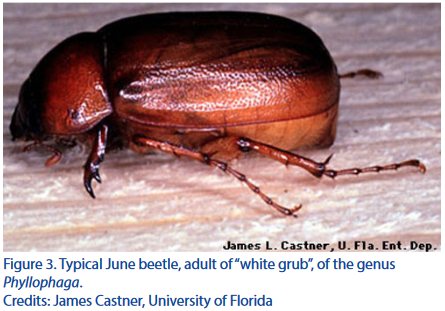
by Sheila Dunning | Apr 23, 2020
Members of the Phyllophaga genus are found throughout Florida and most of North America. One of them is the May/June beetle. Adults are most active during the rainy season. So in parts of the country where the wetter months are May or June, the common name of this insect makes common sense. But, when an area experiences extra rain earlier in the spring, the May/June beetle may emerge from the ground in March or April. That is what has happened in the western Panhandle this spring. May/June beetles have been leaving the soil and flying to the lights of people’s homes.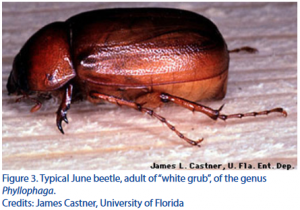
The life cycle of these beetles varies from one to four years. Eggs are laid in soil each spring by females. In 3 to 4 weeks, small grubs (larvae) hatch from eggs and develop through three stages (instars), with the first two stages lasting about 3 weeks. The larvae will move closer to the surface and back deeper in the soil as the soil temperature changes. While close to the surface, larvae feed on grass roots about one inch below the soil surface. Damaged grass turns brown and increases in size over time. Heavy infested turf feels spongy and moves when walked upon. The last larval stage remains in the soil from the fall through spring. The cool soil temperatures drive the larvae deeper in the soil where they remain relatively inactive. Typically, on the third year, white grubs pupate 3 to 6 inches deep in the soil and emerge as adults.
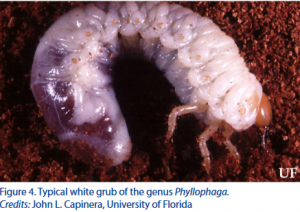 Larvae, called grubs, vary in length from ¾ to 1 ¾ inches depending on the stages. Grubs are white with a C-shaped body with a brown head and three pairs of legs near the head. Adults have ½ to 1 inch long, shiny bodies that are dark yellow to brownish-red in color. Adults do feed on the foliage of several species of ornamental plants, but the damage is typically only aesthetic; not causing long-term harm.
Larvae, called grubs, vary in length from ¾ to 1 ¾ inches depending on the stages. Grubs are white with a C-shaped body with a brown head and three pairs of legs near the head. Adults have ½ to 1 inch long, shiny bodies that are dark yellow to brownish-red in color. Adults do feed on the foliage of several species of ornamental plants, but the damage is typically only aesthetic; not causing long-term harm.
Monitoring of and managing emerging adults can help with deciding on the need for insecticide control for the grubs. To catch and remove adult beetles, place white buckets containing soapy water near plants that have chew marks or areas with lights at night. Leave it overnight. The beetles can easily be disposed of the next day. If there are more than 12 in the bucket be prepared to monitor the lawn for grubs. Extra rain or frequent irrigation during the adult flight time may attract more egg-laying females.
To inspect for grubs, turn over sod to a depth of at least two-inches. If there are an average of three or more per square foot, an insecticide treatment may be needed. To confirm that they are May/June beetles inspect the darkened rear of the grub. Locate the anal slit. It should be Y-shaped with two rows of parallel bristles that point toward each other. This is referred to as the raster pattern. All grub species can be identified using their unique “butt” features.
The most effective time to control this pest is summer or early fall when the larvae are small. Remove as much thatch as possible before applying an insecticide. Spot treat the off-colored area plus the surrounding 10 feet with products containing imidacloprid or halofenozide in early summer. Follow up in the fall with insecticides such as trichlorfon, bifenthrin or carbaryl if grubs persist.
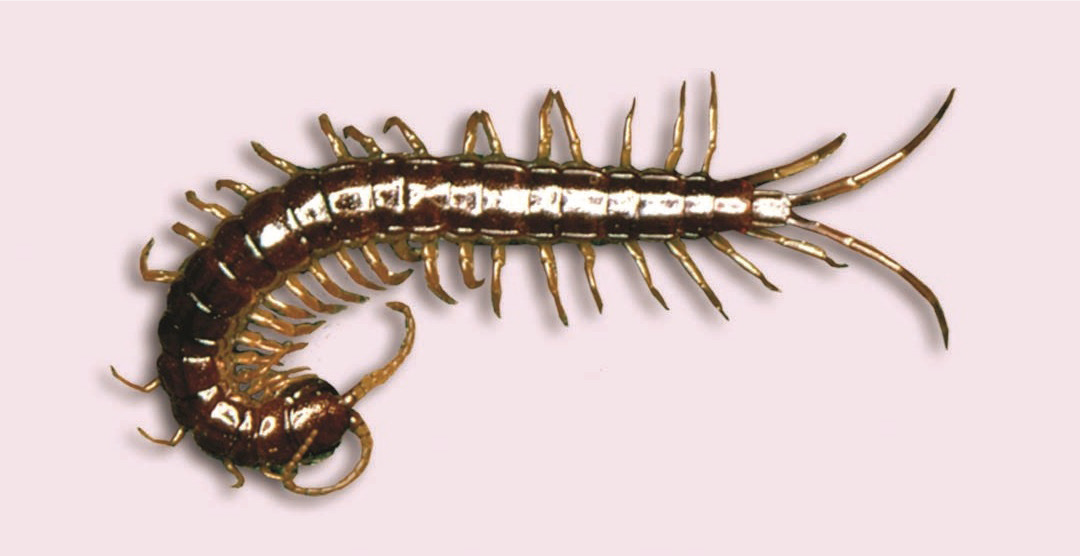
by Sheila Dunning | Mar 20, 2020
Until recently, rainfall has been plentiful. That’s great for the water table and preparing plants to wake up for spring. But, insects are also stirring. Bugs are affected by rain in many ways. When water is plentiful, they can grow faster, reproduce sooner and travel farther. Combine that with the fact that the insects’ homes are being flooded out and their normal food sources are displaced; and where do you think they are headed? Yes, into your house. Four bugs you can anticipate seeing after rain events include cockroaches, sowbugs, ants and centipedes.
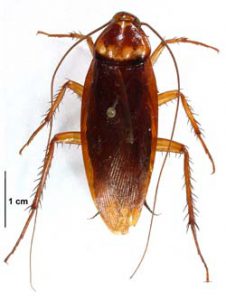
American Cockroach
Photo by: J.L. Castner
UF/IFAS
Roaches tend to live in places that flood easily, especially this time of year. To survive the cold nights, cockroaches need to find a warm place to rest. Typically those places would be drains, pipes, sewers, along foundations and in crawl spaces. But, when it rains, these locations are often flooded, forcing cockroaches to scurry for their lives to avoid drowning. A crack in weather stripping or window caulking makes a quick hideaway. Once inside, they may decide to stay. Frequent rainy days create the lingering humidity that makes all kinds of places more livable for roaches.
Sowbugs and his cousin, the pillbug, are very small, pill-shaped pests with multiple legs and a series of shell-like plates. Often referred to as roly-polys, these creatures are actually a form of land
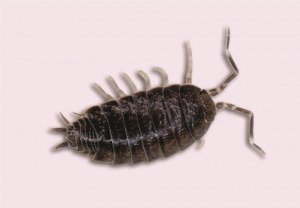
Sowbug
Photo by: J.L. Castner UF/IFAS
crustacean related to lobsters, crabs, and crayfish. The sowbug’s breathing tubes require moisture to function properly, so they must stay near water. Typically this fact restricts the sowbug to living in moist soil or sand. Ending up inside a building is normally a terminal condition for them. However, due to the moisture left in the air after a rain event, sowbugs that seek refuge inside are able to survive for longer periods of time. Given the opportunity, sowbugs will reproduce indoors. If they have decaying organic material to feed on, they may stick around even longer; having time to create a multi-generational infestation.
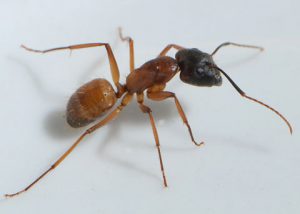
Carpenter Ant
Photo by: J.L.Castner
UF/IFAS
Ants are never too far away. They usually build their colonies in the soil near convenient sources of food and shelter. Being in the ground puts ant colonies at great risk for flooding out, even with short periods of rainfall. When this happens, ants are forces to find higher, drier ground quickly or risk being washed away. What better place than a house? Once inside, the ants get back to work looking for food and building the colony. Expect to see ants around kitchen sinks, on window sills and working their way into cupboards and pantry areas during and after a heavy rain. Unfortunately, if they find all the elements needed to make their home, the ants will be very reluctant to go back outside.
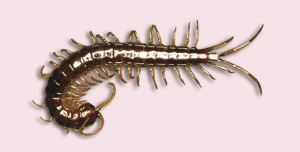
Centipede Photo by: J.L. Castner UF/IFAS
Like the other pests mentioned, centipedes are attracted to humid environments. But, centipedes are active hunting carnivores. They like to feed on roaches, sowbugs and ants. So, they follow them into the house, a well-stocked hunting ground. Centipedes typically only hunt late at night, but in dark areas they can hunt day and night. Finding centipedes if most likely an indication of another pest infestation.
These rain-displaced pests may need some help from a pest control product and/or operator to be discouraged from staying inside. We need the rain. But, keep a close watch for the unwanted visitors.
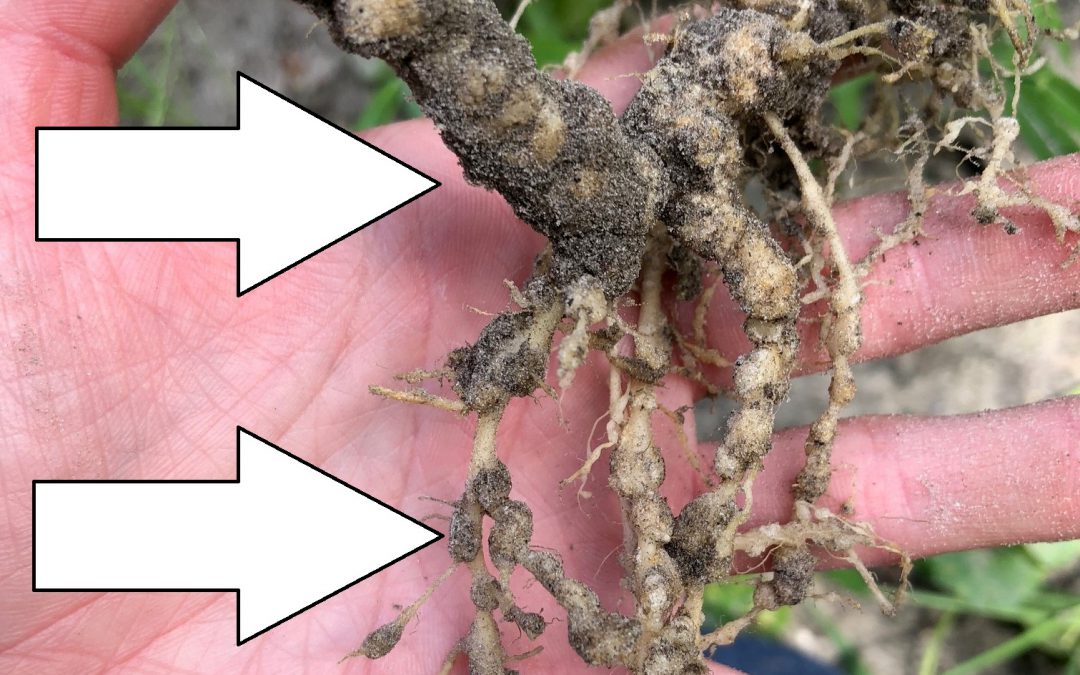
by Danielle S. Williams | Aug 22, 2019
Recently, I received a call about a garden not producing the way it used to. After speaking with the homeowner, I decided to take a visit to see what was going on. On my visit, I could see that the tomatoes were stunted, yellow and wilting, the squash plants were flowering but not setting fruit, and the okra was stunted. After digging up some of the sick plants and examining the roots, the problem was as clear as day…root-knot nematodes.
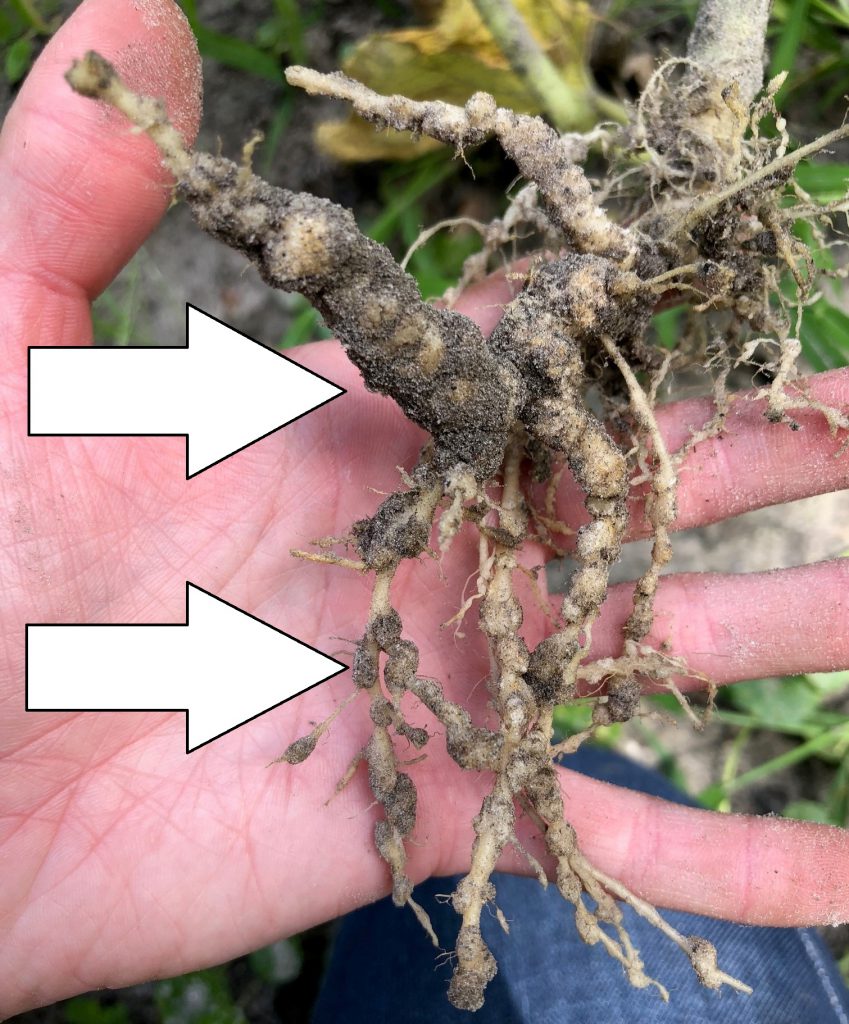
Galls on roots from root-knot nematodes
Root-knot nematodes are microscopic, unsegmented roundworms that live in the soil and feed on the roots of many common garden plants. Some of the most commonly damaged crops are tomatoes, potatoes, okra, beans, peppers, eggplants, peas, cucumbers, carrots, field peas, squash, and melons. Root-knot nematodes enter the root and feed, causing knots or galls to form. These galls are easily recognizable on the roots. If you’re inspecting the roots of beans or peas, be careful not to confuse nematode galls with the nitrogen-fixing nodules that are a normal part of the root system. As the nematodes feed, the root system of the plant becomes damaged and the plant is unable to take up water and nutrients from the soil. As a result, the plant may show symptoms of stunting, yellowing, and wilting.
What can I do about nematodes?
There are currently no nematicides labeled for use in the home garden but the best means of root-knot nematode management involves using a combination of strategies that make your garden less susceptible to attack.
Grow Resistant Varieties
Some varieties of crops are resistant to root-knot nematodes. This means is that a particular nematode can’t reproduce on the plant roots. When buying seed, read the variety label. The label may have ‘VFN’ written in capital letters. These letters indicate that the variety has resistance to certain diseases: V = Verticillium wilt; F = Fusarium wilt; and N = root-knot nematode. It’s best to use resistant varieties when root-knot nematodes are present.
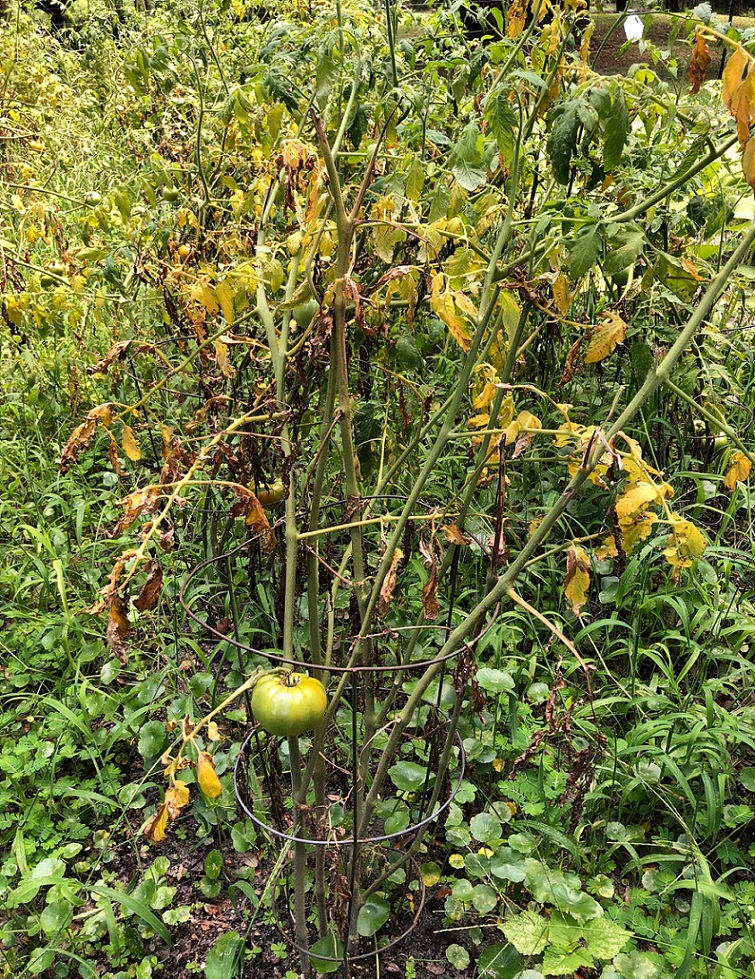
Tomato plant showing signs of nematode damage – yellowing and wilting.
Sanitation
If you suspect you may have a nematode problem, be sure not to move soil or infected plant roots from an infected area to a clean area. Nematodes can easily be spread by garden tillers, hand tools, etc. so be sure to disinfect all equipment after use in problem areas.
Infected roots left in the soil can continue to harbor nematodes. After the crop is harvested, pull up the roots and get rid of them. Tilling the soil can kill nematodes by exposing them to sunlight.
Cover crops and Crop Rotation
Cover crops and crop rotation isn’t just a concept for farmers…gardeners need to implement the same practices! While this may take some planning, it is the most effective way to reduce pests and diseases.
Cover crops are crops that are not harvested and are typically planted between harvestable crops. They help improve soil quality, prevent soil erosion, and help control pests and diseases. Selecting cover crops that aren’t susceptible to root-knot nematode attack is key. When growing a cover crop that nematodes can’t reproduce on, populations should decline or not build up to begin with. Grain sorghum and millet can be planted as a summer cover crop and rye in the winter. French marigolds have been shown to reduce nematode populations as well.
Another simple way to manage root-knot nematodes is by crop rotation. Crop rotation is the practice of not growing crops that are susceptible to nematode attack, in the same spot for more than one year. Crops that aren’t susceptible to attack are cool season crops in the cabbage family such as broccoli, cauliflower, Brussels sprouts, collards and kale.
Root-knot nematodes can wreck havoc on a garden so it’s important to take the necessary precautions to avoid them. It may require planning and patience but it will be worth it in the long run!
For more information on this topic, use the links to the following publications:
Nematode Management in the Vegetable Garden
Featured Creature: Nematodes
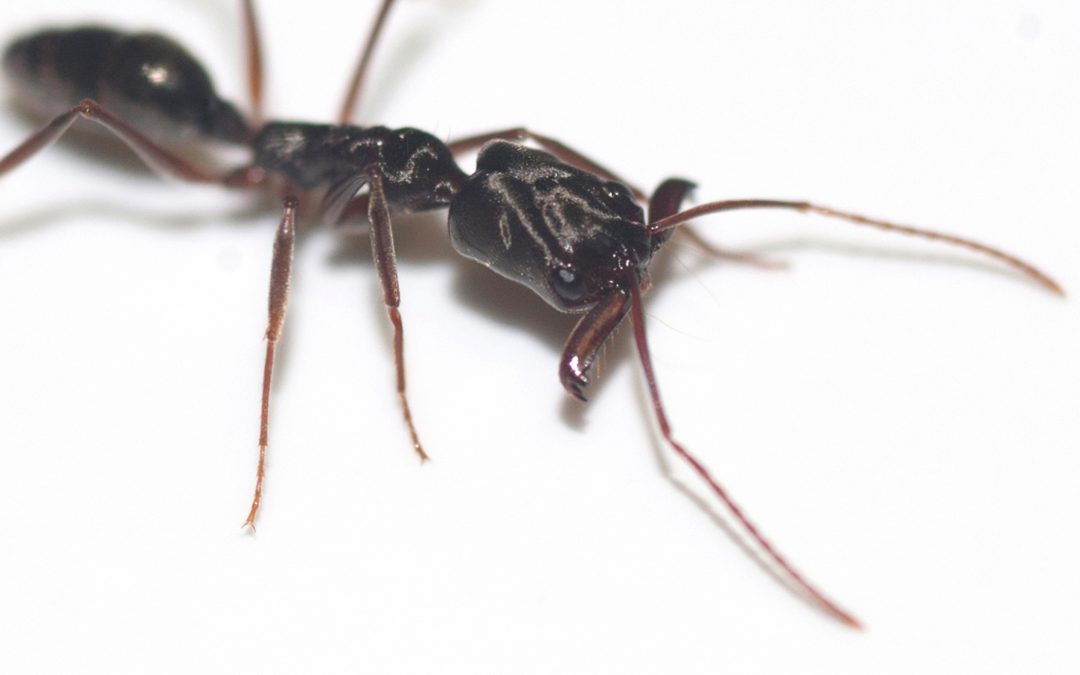
by Beth Bolles | Apr 16, 2019
One of the interesting ants that I am seeing more commonly in landscape settings is the Trap jaw ant (Odontomachus sp.). This ant is so named because of it’s large mandibles (mouthparts) that spring shut capturing prey. These mouthparts can also be used as a defensive mechanism allowing the ant to spring away from something it encounters.
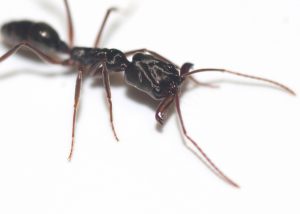
Trapjaw ants. Photo by MSU Ag Communications/Kat Lawrence
A nesting area is very recognizable after you have seen one because it looks like a collection of soil and small wood debris piled at the base of plants or old stumps. I have encountered nesting areas around living shrubs in many mulched areas of the landscape and under pots sitting on old tree stumps.
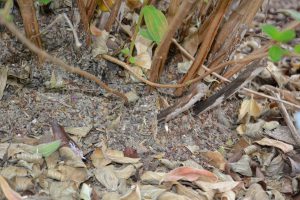
Nesting debris from the Trapjaw ants at the base of a Princess flower. Photo by Beth Bolles, UF / IFAS Extension Escambia County.
My first experience with the trap jaw ant was not very pleasant. I was working in a mulched area pulling a few weeds without gloves. I unknowingly disturbed the nest and received a pain sting similar to a paper wasp sting. The discomfort was short-lived and I personally did not have inflammation or inching a few minutes later. Of course, I identified the ant and have since become very familiar with recognizing nesting spots.
Although trap jaw ants are not native to our area, they do not rank in the same category as fire ants which are both economically and medically problematic. Since trap jaw ants are currently found in more natural areas of the landscape, homeowners should just be aware of their presence. Consider a pair of gloves or garden tools when rooting around in mulch. When a nesting area is disturbed, the large ants (about .5 inches) will be easy to observe as one of the more interesting ants we may encounter.

















